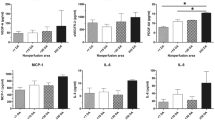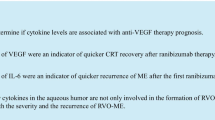Abstract
The objective of this study is to investigate the levels of vascular endothelial growth factor (VEGF) and other cytokines in aqueous humor of patients with idiopathic choroidal neovascularization (CNV) and their effects together with central retinal thickness (CRT) on the response to intravitreal injection of anti-VEGF antibody ranibizumab. This clinical study recruited 32 eyes from 32 patients with CNV under or besides fovea. VEGF, interleukin (IL)-6, IL-8, and monocyte chemoattractant protein (MCP)-1 levels were detected in aqueous humor (0.1 ml) sampled during intravitreal injection. Aqueous humor controls were from nine cataract patients without any systemic disorders. The VEGF levels in aqueous humor were negatively related (r = −0.373, p = 0.035) to CRT, which was positively related (r = 0.743, p < 0.001) to the number of injections. The VEGF levels before treatment and during the third injection in four patients with three or more injections were 13.42 ± 8.50 and 5.75 ± 3.68 (p = 0.055), respectively. The average best corrected visual acuity (BCVA) before and 12 months after treatment were 57.03 ± 16.15 and 75.16 ± 11.78 (p < 0.001), and the average CRT before and 12 months after treatment were 352.09 ± 84.15 and 251.13 ± 63.96 (p < 0.001), respectively. The visual improvement was negatively related (r = −0.815, p < 0.001) to the visual baseline, and the vision 12 months after treatment was positively related (r = 0.581, p < 0.001) to that before treatment. No severe ocular or systemic complication appeared during treatment and follow-ups for all the patients. Intravitreal injection of anti-VEGF antibody ranibizumab is safe and effective for the treatment of idiopathic CNV through decreasing CRT. The patients with larger CRT baseline need more injections of ranibizumab.



Similar content being viewed by others
References
Ho AC, Yannuzzi LA, Pisicano K, DeRosa J (1995) The natural history of idiopathic subfoveal choroidal neovascularization. Ophthalmology 102(5):782–789
Lempert P (1995) Idiopathic subfoveal choroidal neovascularization. Ophthalmology 102(10):1411–1412
Argon laser photocoagulation for idiopathic neovascularization (1983) Results of a randomized clinical trial. Arch Ophthalmol 101(9):1358–1361
Sii F, Lee LR (2006) Retinopathy associated with photodynamic therapy for treatment of idiopathic choroidal neovascularization. Clin Exp Ophthalmol 34(2):184–186
Isola V, Pece A, Parodi MB (2006) Choroidal ischemia after photodynamic therapy with verteporfin for choroidal neovascularization. Am J Ophthalmol 142(4):680–683
Kang HM, Koh HJ (2013) Intravitreal anti-vascular endothelial growth factor therapy versus photodynamic therapy for idiopathic choroidal neovascularization. Am J Ophthalmol 155(4):713–719
Shi X, Wei W, Zhang C (2014) Intravitreal ranibizumab therapy versus photodynamic therapy for idiopathic choroidal neovascularization: a comparative study on visual acuity, retinal and choroidal thickness. Chin Med J 127(12):2279–2285
Carreno E, Moutray T, Fotis K, Lee RW, Dick AD, Ross AH, et al. (2015) Phase IIb clinical trial of ranibizumab for the treatment of uveitic and idiopathic choroidal neovascular membranes. Br J Ophthalmol
Zhou P, Yang L, Jin X (2016) Ranibizumab versus bevacizumab for the treatment of idiopathic choroidal neovascularization: 2-year results. Eur J Ophthalmol 26(3):262–267
Kim H, Lee K, Lee CS, Byeon SH, Lee SC (2015) Subfoveal choroidal thickness in idiopathic choroidal neovascularization and treatment outcomes after intravitreal bevacizumab therapy. Retina 35(3):481–486
Mandal S, Garg S, Venkatesh P, Mithal C, Vohra R, Mehrotra A (2007) Intravitreal bevacizumab for subfoveal idiopathic choroidal neovascularization. Arch Ophthalmol 125(11):1487–1492
Stefansson E, Geirsdottir A, Sigurdsson H (2011) Metabolic physiology in age related macular degeneration. Prog Retinal Eye Res 30(1):72–80
Wankun X, Wenzhen Y, Min Z, Weiyan Z, Huan C, Wei D et al (2011) Protective effect of paeoniflorin against oxidative stress in human retinal pigment epithelium in vitro. Mol Vis 17:3512–3522
Zhao M, Bai Y, Xie W, Shi X, Li F, Yang F et al (2015) Interleukin-1beta level is increased in vitreous of patients with neovascular age-related macular degeneration (nAMD) and polypoidal choroidal vasculopathy (PCV). PLoS ONE 10(5):e0125150
Miao H, Tao Y, Li XX (2012) Inflammatory cytokines in aqueous humor of patients with choroidal neovascularization. Mol Vis 18:574–580
Shah SN, Kang QY, Fan XJ, Sun YM (2016) Optical coherence tomography characteristics of responses to intravitreal bevacizumab in idiopathic choroidal neovascularization. Int J Ophthalmol 9(2):271–274
Shah SN, Kang QY, Fan XJ, Shahbaz F (2015) Microstructural effects of intravitreal bevacizumab in idiopathic choroidal neovascularisation. J Ayub Med Coll 27(2):259–263
Sudhalkar A, Yogi R, Chhablani J (2015) Anti-vascular endothelial growth factor therapy for naive idiopathic choroidal neovascularization: a comparative study. Retina 35(7):1368–1374
Funk M, Karl D, Georgopoulos M, Benesch T, Sacu S, Polak K et al (2009) Neovascular age-related macular degeneration: intraocular cytokines and growth factors and the influence of therapy with ranibizumab. Ophthalmology 116(12):2393–2399
Fauser S, Viebahn U, Muether PS (2015) Intraocular and systemic inflammation-related cytokines during one year of ranibizumab treatment for neovascular age-related macular degeneration. Acta Ophthalmol 93(8):734–738
Muether PS, Neuhann I, Buhl C, Hermann MM, Kirchhof B, Fauser S (2013) Intraocular growth factors and cytokines in patients with dry and neovascular age-related macular degeneration. Retina 33(9):1809–1814
Sakurada Y, Nakamura Y, Yoneyama S, Mabuchi F, Gotoh T, Tateno Y et al (2015) Aqueous humor cytokine levels in patients with polypoidal choroidal vasculopathy and neovascular age-related macular degeneration. Ophthalmic Res 53(1):2–7
Jonas JB, Tao Y, Neumaier M, Findeisen P (2010) Monocyte chemoattractant protein 1, intercellular adhesion molecule 1, and vascular cell adhesion molecule 1 in exudative age-related macular degeneration. Arch Ophthalmol 128(10):1281–1286
Roh MI, Kim HS, Song JH, Lim JB, Koh HJ, Kwon OW (2009) Concentration of cytokines in the aqueous humor of patients with naive, recurrent and regressed CNV associated with AMD after bevacizumab treatment. Retina 29(4):523–529
Kvanta A, Algvere PV, Berglin L, Seregard S (1996) Subfoveal fibrovascular membranes in age-related macular degeneration express vascular endothelial growth factor. Invest Ophthalmol Vis Sci 37(9):1929–1934
Funding
This research was funded by First Affiliated Hospital of Xi’an Jiaotong University fund 2013 (2013YK43).
Author information
Authors and Affiliations
Contributions
Xiaojuan Fan and Ning Gao prepared the manuscript; Jingming Li and Jianqin Lei collected and analyzed the data; and Qianyan Kang designed the study.
Corresponding author
Ethics declarations
Conflict of interests
All authors declare that they have no conflict of interest.
Rights and permissions
About this article
Cite this article
Fan, X., Gao, N., Li, J. et al. Effects of VEGF levels on anti-VEGF therapy for patients with idiopathic choroidal neovascularization. Mol Cell Biochem 441, 173–179 (2018). https://doi.org/10.1007/s11010-017-3183-x
Received:
Accepted:
Published:
Issue Date:
DOI: https://doi.org/10.1007/s11010-017-3183-x




